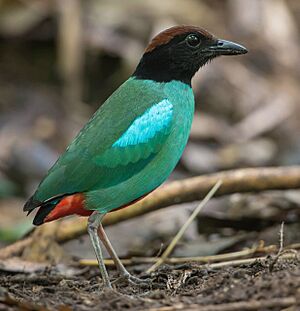Western hooded pitta facts for kids
Quick facts for kids Western hooded pitta |
|
|---|---|
 |
|
| P. sordida subsp. cucullata in Kaeng Krachan National Park, Thailand | |
| Conservation status | |
| Scientific classification | |
| Genus: |
Pitta
|
| Species: |
sordida
|
The western hooded pitta (Pitta sordida) is a colorful bird that belongs to the Pittidae family. You can find this bird in eastern and southeastern Asia, as well as in parts of maritime Southeast Asia. It lives in different types of forests, and sometimes even in farms and planted areas. This bird is mostly green with a black head and a reddish-brown cap. It looks for insects and their larvae on the ground to eat, and it also enjoys berries.
Western hooded pittas build their nests and raise their young between February and August. The parents are very protective of their home area. Both the mother and father bird help to incubate the eggs and care for the baby birds. This bird lives in a wide area, and experts say it is not in danger. The International Union for Conservation of Nature has listed its conservation status as "least concern".
Contents
What is a Western Hooded Pitta?
The western hooded pitta is a medium-sized bird. It usually grows to be about 16 to 19 centimeters (about 6 to 7.5 inches) long. It weighs between 42 and 70 grams (about 1.5 to 2.5 ounces). This bird has a striking appearance with a black head, a chestnut (reddish-brown) crown, and a bright green body and wings.
What Do Western Hooded Pittas Eat?
These birds are ground feeders. This means they look for their food on the ground. Their diet mainly includes different kinds of insects, including their larvae (young insects). They also like to eat berries.
Western Hooded Pitta Reproduction and Life Cycle
The breeding season for western hooded pittas is from February to August. During this time, they build their nests on the ground. Both parent birds work together to take care of the eggs and the young birds, called fledglings. They are very protective of their territory. You can often hear their clear, flute-like calls, which sound like "qweeek-qweeek," coming from their home areas. Sometimes they even call throughout the night!
Where Do Western Hooded Pittas Live?
Western hooded pittas are found across a large area. This includes places from northern India to southern China and Southeast Asia. They live in various types of forests, including lowland forests and even some mountain forests. They can also be found in areas where people live, like plantations and gardens.
Are Western Hooded Pittas in Danger?
The International Union for Conservation of Nature is keeping an eye on this bird. They are concerned about the loss of the bird's natural homes, which is causing their numbers to go down. However, the population is not shrinking fast enough to be considered threatened. Because of this, the western hooded pitta is listed as a "least concern species". This means it is not currently at high risk of disappearing.
Western Hooded Pittas in Zoos
In zoos, western hooded pittas usually get along well with other bird species. However, they might become aggressive towards other pittas when it's breeding season. For example, at the London Zoo, these birds live in a large walk-through bird house. At the Durrell Wildlife Park, they are in a big exhibit with other birds like Palawan peacock-pheasants.
Gallery






